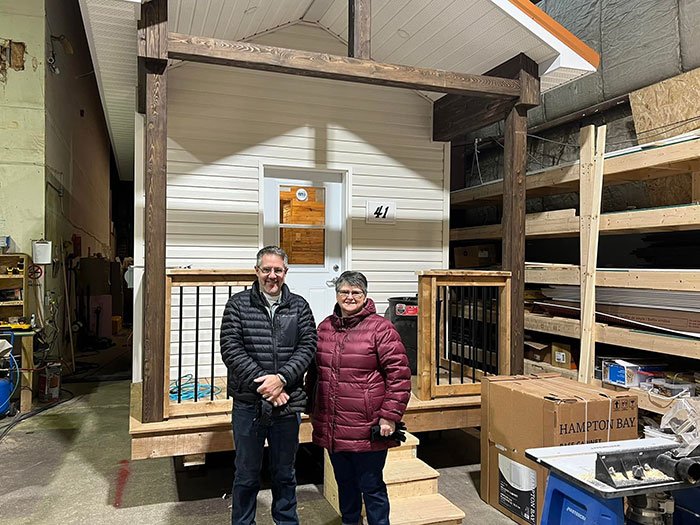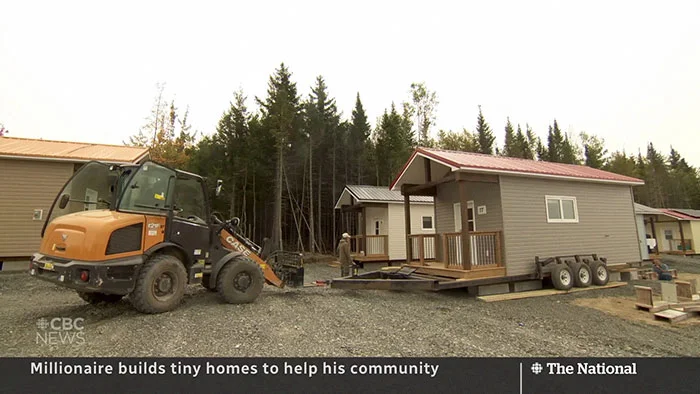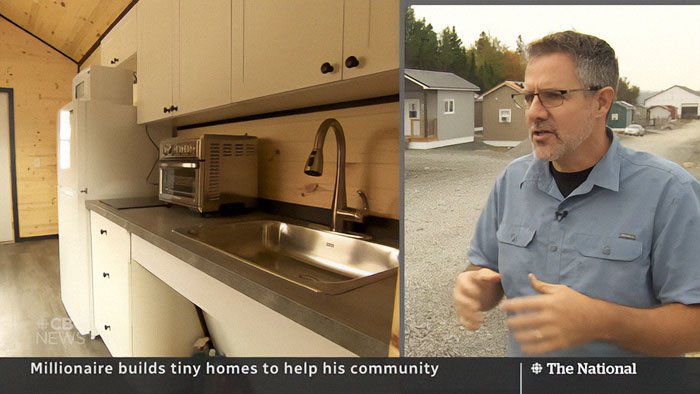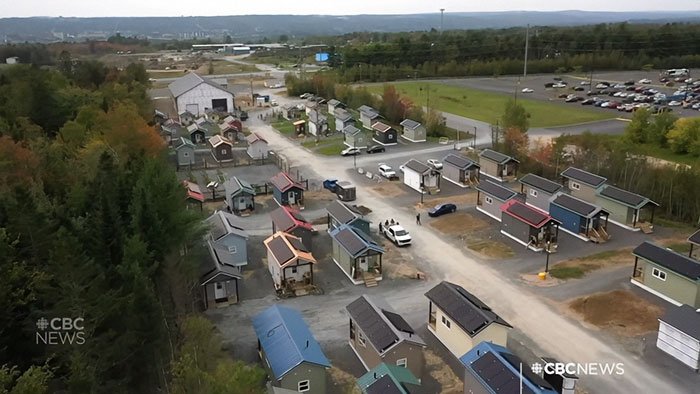Homelessness is a problem that many cities face around the world. Even though governments and organizations are trying to fix it, it’s still a big issue. One Canadian millionaire decided to make a difference in his own town with his money. Here’s his story.
In Fredericton, New Brunswick, Marcel LeBrun, a millionaire entrepreneur, took action to help homeless people in his community. Marcel, who made a lot of money from his successful social media monitoring company, decided to invest $4 million of his own money to build 99 tiny homes for those in need. He didn’t just stop at providing homes; he also created job opportunities with his unique approach. This project is called 12 Neighbours.
After selling his company and gaining a lot of wealth, Marcel wanted to use his money for good. Seeing the homelessness issue in Fredericton, he came up with the idea of a tiny home community to give homeless people a new start. He named his project 12 Neighbours and aimed to build a gated community with 99 homes and an enterprise center. This community offers both housing and job opportunities, giving homeless people a chance to rebuild their lives.

Homelessness is a big issue in New Brunswick, with about 1,600 people experiencing it in a single day last year. In bigger cities like San Francisco, Los Angeles, and New York in the United States, the number of homeless people is much higher. Marcel LeBrun saw a chance to make a difference and decided to help those struggling with homelessness.
Marcel’s project, 12 Neighbours, is not just about building tiny homes. He wants to create a supportive community for people. The tiny homes he’s building are more than just places to stay. They are fully-furnished with kitchens, living areas, bedrooms, and full bathrooms. They even have solar panels on the roofs. Marcel sees himself as a community builder, aiming to provide a better life for those in need.

To make his vision a reality, Marcel LeBrun set up a factory where skilled volunteers help build the tiny homes. Using modern techniques, the factory can produce one tiny home every four business days. Once a home is built, it is carefully placed on concrete blocks to form the foundation of the community.
Marcel believes that owning a home is important because it gives people a sense of responsibility and stability. By allowing people who have experienced homelessness to own their own homes, the 12 Neighbours project aims to empower them and create a supportive community.

Besides providing homes, Marcel LeBrun’s project also focuses on creating job opportunities for the residents. The 12 Neighbours community includes an enterprise center with a coffee bar and a silk printing business, both run by the residents. This helps generate income and encourages residents to interact with the wider community.
Like any big project, 12 Neighbours has faced criticism. Some people think it’s better to reintegrate homeless individuals directly into society rather than keeping them together in one place. However, Marcel understands these concerns and has taken steps to ensure the community is safe and supportive.
Marcel explained, “Building a few homes is just as complicated as building many, and we wanted to make a real impact on homelessness in Fredericton. If we want to make a meaningful difference, we need to build houses. If I take someone who’s been living outside and put them in a luxury apartment, they might not succeed because it’s not their community or environment.”

Marcel LeBrun knows how important safety is, so he has included top security features in the 12 Neighbours community. There are gated entrances and advanced surveillance systems to ensure residents feel safe and protected.
LeBrun mentioned that some residents face challenges when they first move in. He explained, “When someone moves into a house, they might have others trying to take advantage of them. They need to learn what it means to manage their own space and decide who they let in and out.”
One of the main goals of 12 Neighbours is to build a strong sense of community both inside and outside its gates. LeBrun wants to create a place where residents and the people of Fredericton can come together. The community has a coffee bar and a personalized printing business to encourage interaction and understanding.
LeBrun told CBC, “I see myself as a community builder. We’re not just building a small community; we’re helping to make our city better.”
Marcel LeBrun’s project to build 99 tiny homes in Fredericton, New Brunswick, is a great example of using personal success to help others. Through 12 Neighbours, he has not only provided homes for those in need but also created job opportunities and a supportive community. His efforts have given hope to many and inspired others to make a difference.
I Was the Only One Who Went to My Grandma’s Birthday Brunch — After Seeing Her Tears, I Taught My Family a Lesson

My dear Gran-Gran invited our family to celebrate her birthday, and that’s when it all began. I had no idea that my family would let her down in such a painful way. I was resolved to impart a lesson on them that they would never be able to forget.

Gran-Gran is a remarkable woman who raised my siblings and me essentially during our parents’ divorce. She is everything to me, thus I found it incomprehensible that the other members of my family could let her down.
Rather than having us arrange something exceptional for her 83rd birthday, Gran-Gran decided to host a brunch at her home. She got up early to bake her own bread and pastries in spite of her health problems. Even though her hands were shaking, she wrote and assembled the invitations herself.

I was inspired to attend by Gran-Gran’s special day by the time and work she put into it. Regretfully, work obligations caused me to arrive ten minutes late. I was astonished to find my grandmother clearing dishes off the table and putting coffee down the sink when I first went in.
I questioned Gran-Gran why there was nobody else at the celebration, feeling both confused and worried. She told me, fighting back tears, that nobody had bothered to come. Her attempts to conceal her disappointment and act as though everything was fine crushed my heart.

I was unable to overlook this. I vowed to myself that I would make up to Gran-Gran and leave my family with a lasting lesson. I excused myself and went outside to make some phone calls after spending some quality time with her.
Initially, I informed my mother over the phone that my grandmother had fallen and was currently in the hospital. I put her under pressure by telling her that if she had gone to the brunch, the accident might have been prevented. My mother consented to send funds to pay the fictitious hospital expenses.

Next, I called my brother and asked him why he hadn’t been there. I informed him that Gran-Gran was hospitalized and that his presence might have had an impact. He said he would pay some money toward the imaginary bills.
I called additional relatives in a similar way, making them feel bad and persuading them to contribute money for the purported hospital bills. I surprised Gran-Gran with a trip to a stunning location she had always wanted to see with the money we raised.
We made wonderful memories together and lavishly celebrated her birthday during our time together. Gran-Gran was beaming with happiness when we got home. My family never missed another event after that day. Every birthday, holiday, and Sunday meal they attended.

I had no remorse about what I did, even though they still gave me the cold shoulder over it. Gran-Gran’s joyful expression made it all worthwhile. How would you have responded if you had been in my position? Tell me what you think.
Though it has been romanticized for artistic purposes, this work draws inspiration from actual individuals and events. For reasons of privacy protection and story improvement, names, characters, and details have been changed. Any likeness to real people, alive or dead, or real events is entirely accidental and not the author’s intention.
The publisher and author disclaim all liability for any misinterpretation and make no claims on the veracity of the events or character portrayals. The thoughts represented in this story are those of the characters and do not necessarily represent the viewpoints of the author or publisher. The story is offered “as is.”



Leave a Reply